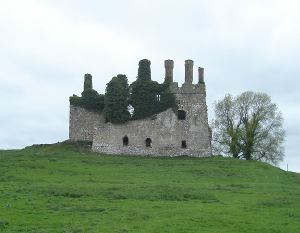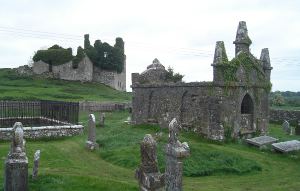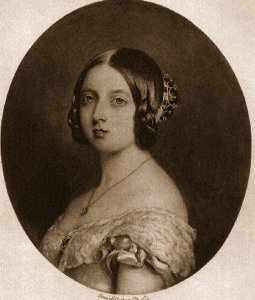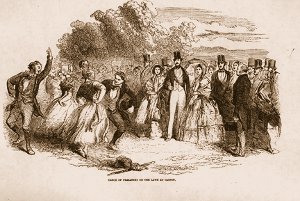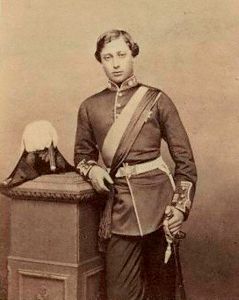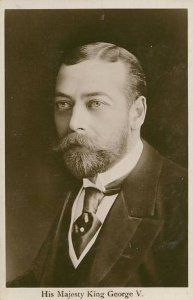County Kildare
Always Popular with Visiting Royals
Published in the Kildare Nationalist, 17th May 2011
There have been many royal visits over the centuries to Ireland, and visits to county Kildare have been on the agenda on most occasions. The visit of Queen Elizabeth in May 2011 brought to ten the number of English monarchs that have come Ireland since 1171, and all of them have either visited or travelled through county Kildare.
Queen Elizabeth, unlike the other monarchs, has a strong personal connection to county Kildare, as some of her ancestors were from the county. One of the most noteworthy of her Kildare ancestors was Richard Colley-Wellesley who was born in Carbury Castle circa 1690. He was her 5th great grandfather on her mother’s side.1
Six generations of the Queen’s Colley ancestors lived in Carbury Castle, beginning with Sir Henry Colley. He acquired a leasehold of Carbury in 1538 during the reign of King Henry VIII. Then in 1569 he was granted the Manor of Carbury by Queen Elizabeth I. It was Sir Henry who remodeled the Castle in the style of the Elizabethan period, and today the striking ruins of Carbury Castle can be seen on an elevated site, which dominates north west Kildare. Sir Henry also built the Colley mortuary chapel close to his residence, and it is here where he rests with several other Colley ancestors of the Queen.2
Henry II was the first English King to visit Ireland, and he passed through the area of the ‘Liffey Plain’ that later became county Kildare on two occasions. Firstly, on his route from Munster to Dublin in late 1171, and again in the spring of 1172, when he travelled to Wexford to embark on his return journey to England. His son, John, also visited Ireland on two occasions. The first occasion was in his capacity as Justiciar between April and December 1185. He landed in Waterford, and travelled to Dublin also by way of the ‘Liffey Plain’. It is reported that along the way he built a number of Castles. His second trip was in 1210 when he came as King. On this occasion he stayed in Naas and built a strong castle, now called King John’s Castle.
Richard II was the third English King to visit. He arrived on the 2nd of October 1394, and returned home in July 1395. Like his predecessors, he landed in the south and travelled through county Kildare on his way to Dublin. These were troubled times in Ireland, with Art MacMurrough Kavanagh causing King Richard untold difficulties; this led to his return to Ireland in May 1399. However, his second trip was an ill-fated event that had to be cut short due a serious threat to his authority in England. On his return he was deposed by his cousin, who became Henry IV.
Almost three centuries were to pass before there was another visit from an English King. In 1689 King James II, having lost the Crown of England to William of Orange, arrived in Ireland. The Lord Lieutenant the Duke of Tyrconnell, who lived in Carton and himself a Kildare man, had held Ireland for James. James landed in the south. On his way to Dublin, tradition has it that he stayed in Castlemartin Castle near Kilcullen. It is known that he briefly resided and held court in the original Viceregal Lodge, in Chapelizod. This building was known in later years as ‘The King’s House’. The conflict for the crown of the three Kingdoms of England, Scotland and Ireland which arose between James and his son-in-law, William of Orange, ended with the latter’s victory at the Battle of the Boyne in 1690. King James, however, did not wait to see the end of the battle but rode at speed back to Dublin where he was confronted by Lady Tyrconnell, wife of the Lord Lieutenant, who politely asked him who had won the battle. His reply was ‘your husband’s country men made good their heels at the Battle’—in other words the Irish ran away. The good lady sarcastically replied, ‘then I see your majesty has won the race’.3
Following the battle, a victorious King William made his way south to Limerick. It is recorded that he travelled uneventfully through county Kildare and at Castledermot conducted some affairs of state by way of correspondence.4
One hundred and thirty years was to pass before there was another royal visit when King George IV became the first monarch of the nineteenth century to visit Ireland in 1821. He had come previously in 1816 when he was regent. The King landed at Dún Laoghaire on September 4th, 1821, and this led to the town being named Kingstown. During his visit he attended the September race meeting at the Curragh. The event was an occasion of great excitement and £3,000 was raised to erect a new stand and marquees for the masses. At the race meeting the King presented ‘The Royal Whip’ (a trophy whose handle was decorated with gold shamrocks) to encourage horse breeding in Ireland.5
George’s niece, Queen Victoria, visited the country on four occasions during her reign in 1849, 1853, 1861 and 1900. In 1840 her wedding to Prince Albert was celebrated in the town of Kilcullen with particular fervour where there was a street party on the wedding night that ended with three cheers for the royal bride and one for the illustrious consort.6
Her first visit in 1849 was just two years after the Famine. Accompanied by Prince Albert she landed at Cobh which was subsequently renamed Queenstown in her honour. During the trip the royal couple visited Carton, making their way along the banks of the Liffey through Lucan demesne in a coach and four from the Vice Regal Lodge—now Áras an Uachtaráin—in the Phoenix Park, emerging at Leixlip Bridge, where local lore has it that she was presented with a bunch of flowers by a young girl.7 The couple spent one night at Carton as a guest of the Duke of Leinster. On their arrival at Carton, they were greeted with proper decorum by the local military corps and many local residents. On the lawn of Carton the royal party were entertained by Irish dancing performed by members of Fr. Mathew’s temperance movement. She thoroughly enjoyed the jigs and reels, indicating that ‘they were different from the Scottish reels, not so animated and the steps, very different, very droll’.8
On her second trip to Ireland in 1861, she travelled to the Curragh Camp where her son and heir, the Prince of Wales and future King Edward VII, was undergoing a period of military instruction at the Camp. One of the highlights was the Queen’s inspection and grand review of all the troops in the Camp. She was entertained by a piper from the locality, and as a gesture of thanks she presented him with a set of silver mouthed Irish pipes.9 While Prince Edward was stationed in the Curragh, the Aylmer Tower was under construction on the summit of the Hill of Allen. The Prince could clearly see the structure from the Camp and in September 1861, he visited the site from which he could see panoramic views of virtually the entire county of Kildare and the Wicklow mountains. Edward made many subsequent visits to Ireland and attended Punchestown Races on a number of occasions.
As King in 1904 he attended the two day event at Punchestown and was accompanied by his wife, Queen Alexandria, on the first day. The royal party arrived in Naas by train each day to an awaiting coach. Bands played and crowds cheered as their entourage made its way through the town and on to the races. It was a lavish occasion in which Switzers of Dublin fashioned arches across the Main Street of Naas and the Royal coat of arms was draped on the courthouse.
King Edward and his Queen paid a private visit to Maynooth College on the 24th of July 1903. The royal party were cordially cheered as they drove from the train station through the town to the College gates. They were welcomed by a substantial number of Ireland’s leading Catholic bishops and red carpets covered the stone floors of the cloisters. The Royal couple visited the Chapel and in the sacristy were shown a set of robes presented to the College by the late Empress Elizabeth of Austria. During the visit the King reminded his hosts of a visit he made to the college on a previous occasion.10
King George V also visited Maynooth College shortly after he ascended the throne in 1911. Accompanied by his wife Queen Mary, the royal party were driven by motor car from the Vice Regal Lodge to Maynooth, where they were greeted by a massive crowd of people who lined the main Street as the royal entourage passed. At the entrance to the College, the royal party was greeted by Cardinal Logue and virtually the entire aristocracy of the Irish Catholic Church.11 The King and Queen were brought on a tour of the College similar to the previous royal visit.
However, the visit occurred during a period of national revival when nationalism in the country was at fever pitch and there were some opposition in Maynooth to the visit with the local band split on the issue. The previous day there was a nationalist pilgrimage to Bodenstown where sentiments of opposition to the royal visit were also expressed.
King George V is remembered favorably in Irish history. Ten years after the visit the ‘War of Independence’ was raging in the country and there appeared to be no end of the conflict in sight. An official opening of the new Parliament of Northern Ireland by the King was planned for the 22nd of June 1921 and the occasion was regarded as a suitable opportunity to offer a message of peace to the whole of Ireland. The King, who had made his unhappiness at the behavior of the Black and Tans in Ireland well known to his government12, was dissatisfied with the official speech prepared for him by Lloyd George for the opening ceremony. Another draft of a speech in which there was a significant input from the King with the assistance of General Smuts of South Africa was prepared and accepted by Cabinet. King George delivered the speech in Belfast as planned. It had an immediate impact and led to the Truce which was signed less than three weeks after the speech was delivered. This allowed negotiations regarding Ireland’s constitutional position between the British Government and Irish representatives to commence and led to the Treaty in December of 1921.
It could be argued that negotiations regarding Ireland’s constitutional position between the two governments continued on and off until the Good Friday agreement was signed in 1998.
Arguably, King George V did more to end the British–Irish conflict than any of his predecessors. However, one question relating to the King and Ireland needs to be asked—has history given him the credit for his role in the initiative that brought about the truce and its subsequent consequences?
- See Burkes Peerage for details of the Wellington and Mornington family connection with the Colley’s of Carbury.
- Details are contained on a plaque in the mortuary chapel.
- For details of Lady Tyrconnell’s connection to Rathcoffey, see The Founding of Rathcoffey Chapel on this website.
- J.G. Simms, Jacobite Ireland, Dublin, 2000, p 162.
- History of Irish Racing, goracing.ie
- Freemans Journal, 13 February 1840
- My thanks to John Colgan, Historian Leixlip for details of the Leixlip connection.
- John Drennan, Cannonballs and Croziers: A History of Maynooth, Maynooth, 1994, p 54.
- Con Costello, A Most Delightful Station, Cork, 1999, p 102.
- Kildare Observer, 1 August 1903.
- Kildare Observer, 15 July 1911.
- Michael Hopkinson, The Last Days of Dublin Caste: The Mark Sturgis Diaries, Dublin, 1999, p 176.

